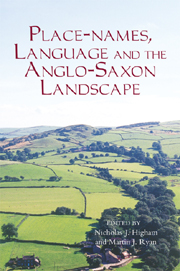Book contents
- Frontmatter
- Contents
- List of Illustrations
- Acknowledgements
- List of Contributors
- Abbreviations
- 1 Place-Names, Language and the Anglo-Saxon Landscape: An Introduction
- 2 The Landscape of Place-Name Studies
- 3 Place-Names as Travellers' Landmarks
- 4 Light thrown by Scandinavian Place-Names on the Anglo-Saxon Landscape
- 5 Language and the Anglo-Saxon Landscape: Towards an Archaeological Interpretation of Place-Names in Wiltshire
- 6 Hunting the Vikings in South Cumbria from Ambleside to Haverbrack
- 7 Viking-Age Amounderness: A Reconsideration
- 8 The Woodland Landscape of Early Medieval England
- 9 The Pre-Conquest Lands and Parish of Crediton Minster, Devon
- 10 Rewriting the Bounds: Pershore's Powick and Leigh
- 11 That ‘Dreary Old Question’: The Hide in Early Anglo-Saxon England
- 12 Boroughs and Socio-Political Reconstruction in Late Anglo-Saxon England
- Index
6 - Hunting the Vikings in South Cumbria from Ambleside to Haverbrack
Published online by Cambridge University Press: 05 February 2013
- Frontmatter
- Contents
- List of Illustrations
- Acknowledgements
- List of Contributors
- Abbreviations
- 1 Place-Names, Language and the Anglo-Saxon Landscape: An Introduction
- 2 The Landscape of Place-Name Studies
- 3 Place-Names as Travellers' Landmarks
- 4 Light thrown by Scandinavian Place-Names on the Anglo-Saxon Landscape
- 5 Language and the Anglo-Saxon Landscape: Towards an Archaeological Interpretation of Place-Names in Wiltshire
- 6 Hunting the Vikings in South Cumbria from Ambleside to Haverbrack
- 7 Viking-Age Amounderness: A Reconsideration
- 8 The Woodland Landscape of Early Medieval England
- 9 The Pre-Conquest Lands and Parish of Crediton Minster, Devon
- 10 Rewriting the Bounds: Pershore's Powick and Leigh
- 11 That ‘Dreary Old Question’: The Hide in Early Anglo-Saxon England
- 12 Boroughs and Socio-Political Reconstruction in Late Anglo-Saxon England
- Index
Summary
The purpose of this chapter is to consider what can be learned about the landscape of South Cumbria during the Anglo-Saxon period by the study of those currently extant place-names which can reasonably be believed to date from that period. Before starting on this discussion, it is necessary to define the area designated as South Cumbria. So, for the purposes of this chapter, South Cumbria covers all of Westmorland; the North Lonsdale ward of Lancashire, and the Copeland area of Cumberland.
The northern boundary of Westmorland, which is also the boundary of the area under discussion here, follows a line from Yorkshire until it meets the old Cumberland boundary at the head of Wrynose Pass. The northern boundary of South Cumbria then continues to the coast as the border of the Copeland (or Allerdale above Derwent) district of Cumberland. The North Lonsdale ward of Lancashire borders on both Copeland and Westmorland and constitutes the part of Lancashire which was on the northern coast of Morecambe Bay, known as ‘Lancashire-North-of-the-Sands’. Modern Cumbria also includes a portion (the Craven district) of what was Yorkshire before 1974. This chapter does not cover the parts of Yorkshire now absorbed into Cumbria.
It has been usual in the past to think of place-names in county units, as exemplified by the many county volumes of the English Place-Names Survey. More recently, such scholars as Gillian Fellows-Jensen have moved on to considering wider areas, for example the north-west of England.
- Type
- Chapter
- Information
- Place-names, Language and the Anglo-Saxon Landscape , pp. 105 - 124Publisher: Boydell & BrewerPrint publication year: 2011



